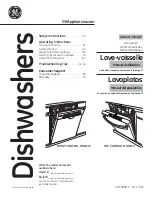
9
Loading the Dishwasher
Do not pre-wash items with loosely attached soiling. Remove all food particles, bones, toothpicks and
excessive grease. Items having burned-on, baked-on or starchy soils may require some pretreatment.
Refer to the Dishware Materials section for more information about dishware suitability.
Load only dishwasher safe items into the dishwasher. Load dishes in the dishwasher racks so the
insides of bowls, pots and pans are facing the spray arms as shown. Avoid nesting and contact points
between dishes. Separate items of dissimilar metals. Use care to not block movement of the spray
arms.
WARNING
The sharp points and edges of knives and other sharp utensils can cause serious injuries. Load knives
and other sharp utensils with edges down. Do not allow children to handle or play near knives and
sharp utensils.
NOTICE
To avoid dishwasher damage, do not load the dishwasher with paper products, plastic bags, packing
materials or anything other than normal, dishwasher safe dishware and kitchenware.
Loading the Upper Rack
Ensure items do not protrude through the bottom of the racks and block the spray arms.
NOTE: When pushing the upper rack into the dishwasher, push it until it stops against the back of the tub so the
upper rack spray arm connects to the water supply at the back of the tub. Do not push racks in using the door.
Loading the Lower Rack
Place large items in the lower rack. Load pots, pans and bowls upside down. Do not block vent with tall
baking sheets. Load these items on the right side of the dishwasher.
Unloading the Dishwasher
When unloading the dishwasher, it is recommended to unload the lower rack first. Next, unload the sil-
verware basket followed by the upper rack. This prevents water from dripping down onto dishware.
NOTE: Dishes are more likely to chip when unloading before cooling.











































